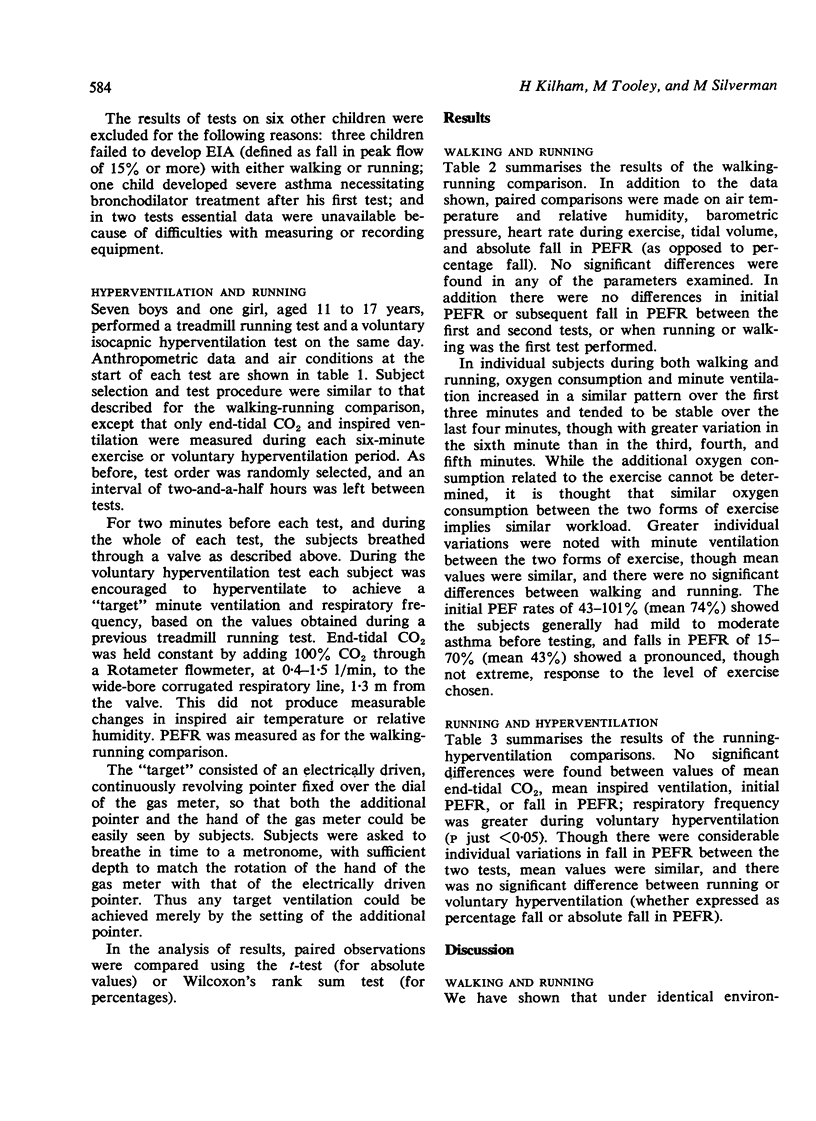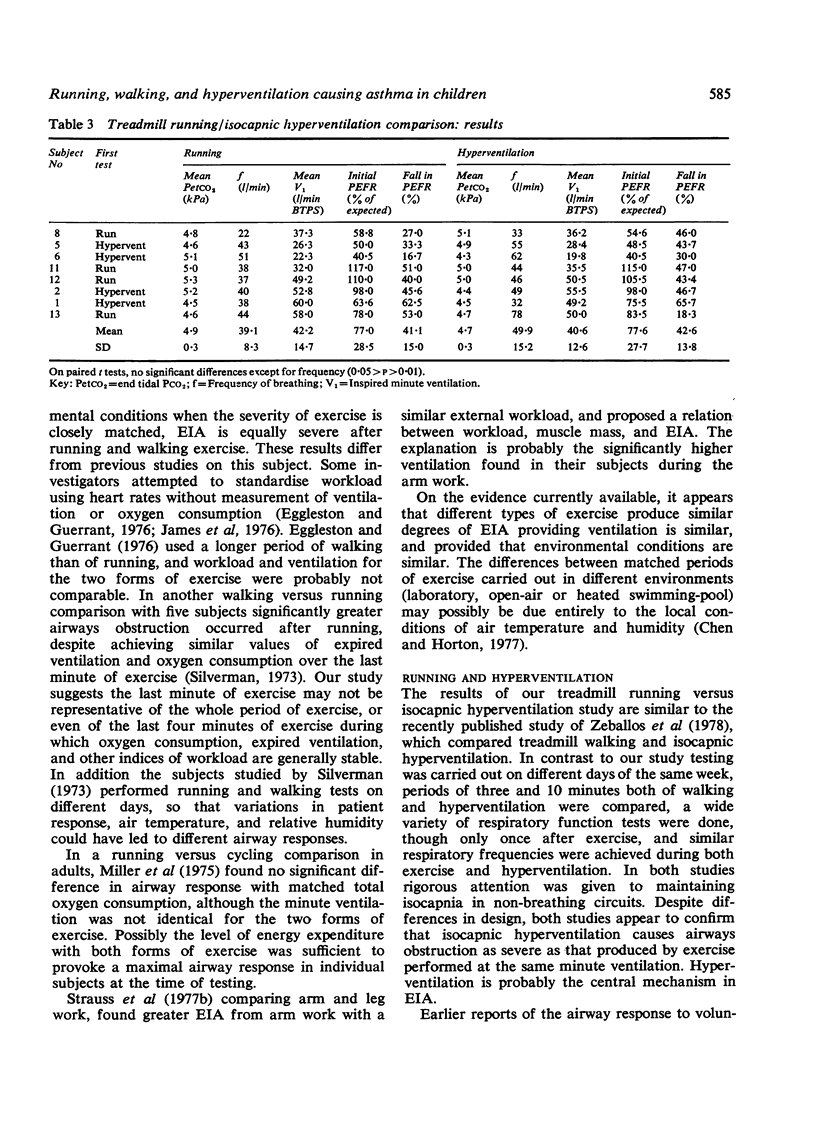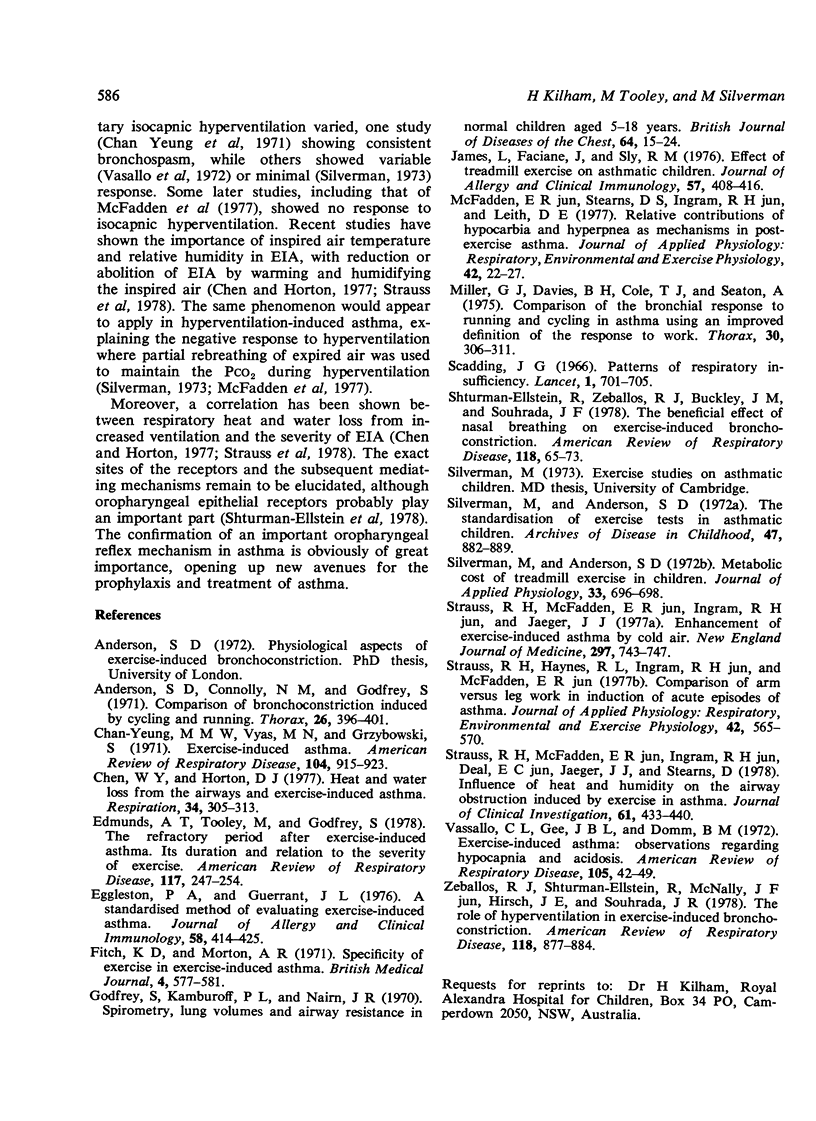Abstract
To examine further the relation between type of exercise, workload, ventilation, and exercise-induced asthma, we compared treadmill walking with treadmill running and treadmill running with isocapnic hyperventilation in separate studies in children and adolescents. Inspired air conditions were identical during each pair of tests. Walking and running with similar minute ventilation and oxygen consumption were followed by similar falls in peak expiratory flow rate as were running and hyperventilation with similar minute ventilation and end-tidal carbon dioxide tension. This study supports the concept that hyperventilation is a central mechanism in exercise-induced asthma.
Full text
PDF




Selected References
These references are in PubMed. This may not be the complete list of references from this article.
- Anderson S. D., Connolly N. M., Godfrey S. Comparison of bronchoconstriction induced by cycling and running. Thorax. 1971 Jul;26(4):396–401. doi: 10.1136/thx.26.4.396. [DOI] [PMC free article] [PubMed] [Google Scholar]
- Chan-Yeung M. M., Vyas M. N., Grzybowski S. Exercise-induced asthma. Am Rev Respir Dis. 1971 Dec;104(6):915–923. doi: 10.1164/arrd.1971.104.6.915. [DOI] [PubMed] [Google Scholar]
- Chen W. Y., Horton D. J. Heat and water loss from the airways and exercise-induced asthma. Respiration. 1977;34(6):305–313. doi: 10.1159/000193842. [DOI] [PubMed] [Google Scholar]
- Edmunds A. T., Tooley M., Godfrey S. The refractory period after exercise-induced asthma: its duration and relation to the severity of exercise. Am Rev Respir Dis. 1978 Feb;117(2):247–254. doi: 10.1164/arrd.1978.117.2.247. [DOI] [PubMed] [Google Scholar]
- Eggleston P. A., Guerrant J. L. A standardized method of evaluating exercise-induced asthma. J Allergy Clin Immunol. 1976 Sep;58(3):414–425. doi: 10.1016/0091-6749(76)90122-6. [DOI] [PubMed] [Google Scholar]
- Fitch K. D., Morton A. R. Specificity of exercise in exercise-induced asthma. Br Med J. 1971 Dec 4;4(5787):577–581. doi: 10.1136/bmj.4.5787.577. [DOI] [PMC free article] [PubMed] [Google Scholar]
- Godfrey S., Kamburoff P. L., Nairn J. R. Spirometry, lung volumes and airway resistance in normal children aged 5 to 18 years. Br J Dis Chest. 1970 Jan;64(1):15–24. doi: 10.1016/s0007-0971(70)80045-6. [DOI] [PubMed] [Google Scholar]
- James L., Faciane J., Sly R. M. Effect of treadmill exercise on asthmatic children. J Allergy Clin Immunol. 1976 May;57(5):408–416. doi: 10.1016/0091-6749(76)90055-5. [DOI] [PubMed] [Google Scholar]
- McFadden E. R., Jr, Stearns D. R., Ingram R. H., Jr, Leith D. E. Relative contributions of hypocarbia and hyperpnea as mechanisms in postexercise asthma. J Appl Physiol Respir Environ Exerc Physiol. 1977 Jan;42(1):22–27. doi: 10.1152/jappl.1977.42.1.22. [DOI] [PubMed] [Google Scholar]
- Miller G. J., Davies B. H., Cole T. J., Seaton A. Comparison of the bronchial response to running and cycling in asthma using an improved definition of the response to work. Thorax. 1975 Jun;30(3):306–311. doi: 10.1136/thx.30.3.306. [DOI] [PMC free article] [PubMed] [Google Scholar]
- Scadding J. G. Patterns of respiratory insufficiency. Lancet. 1966 Mar 26;1(7439):701–705. doi: 10.1016/s0140-6736(66)91643-6. [DOI] [PubMed] [Google Scholar]
- Shturman-Ellstein R., Zeballos R. J., Buckley J. M., Souhrada J. F. The beneficial effect of nasal breathing on exercise-induced bronchoconstriction. Am Rev Respir Dis. 1978 Jul;118(1):65–73. doi: 10.1164/arrd.1978.118.1.65. [DOI] [PubMed] [Google Scholar]
- Silverman M., Anderson S. D. Metabolic cost of treadmill exercise in children. J Appl Physiol. 1972 Nov;33(5):696–698. doi: 10.1152/jappl.1972.33.5.696. [DOI] [PubMed] [Google Scholar]
- Silverman M., Anderson S. D. Standardization of exercise tests in asthmatic children. Arch Dis Child. 1972 Dec;47(256):882–889. doi: 10.1136/adc.47.256.882. [DOI] [PMC free article] [PubMed] [Google Scholar]
- Strauss R. H., Haynes R. L., Ingram R. H., Jr, McFadden E. R., Jr Comparison of arm versus leg work in induction of acute episodes of asthma. J Appl Physiol Respir Environ Exerc Physiol. 1977 Apr;42(4):565–570. doi: 10.1152/jappl.1977.42.4.565. [DOI] [PubMed] [Google Scholar]
- Strauss R. H., McFadden E. R., Jr, Ingram R. H., Jr, Deal E. C., Jr, Jaeger J. J. Influence of heat and humidity on the airway obstruction induced by exercise in asthma. J Clin Invest. 1978 Feb;61(2):433–440. doi: 10.1172/JCI108954. [DOI] [PMC free article] [PubMed] [Google Scholar]
- Strauss R. H., McFadden E. R., Jr, Ingram R. H., Jr, Jaeger J. J. Enhancement of exercise-induced asthma by cold air. N Engl J Med. 1977 Oct 6;297(14):743–747. doi: 10.1056/NEJM197710062971402. [DOI] [PubMed] [Google Scholar]
- Vassallo C. L., Gee J. B., Domm B. M. Exercise-induced asthma. Observations regarding hypocapnia and acidosis. Am Rev Respir Dis. 1972 Jan;105(1):42–49. doi: 10.1164/arrd.1972.105.1.42. [DOI] [PubMed] [Google Scholar]
- Zeballos R. J., Shturman-Ellstein R., McNally J. F., Jr, Hirsch J. E., Souhrada J. F. The role of hyperventilation in exercise-induced bronchoconstriction. Am Rev Respir Dis. 1978 Nov;118(5):877–884. doi: 10.1164/arrd.1978.118.5.877. [DOI] [PubMed] [Google Scholar]


